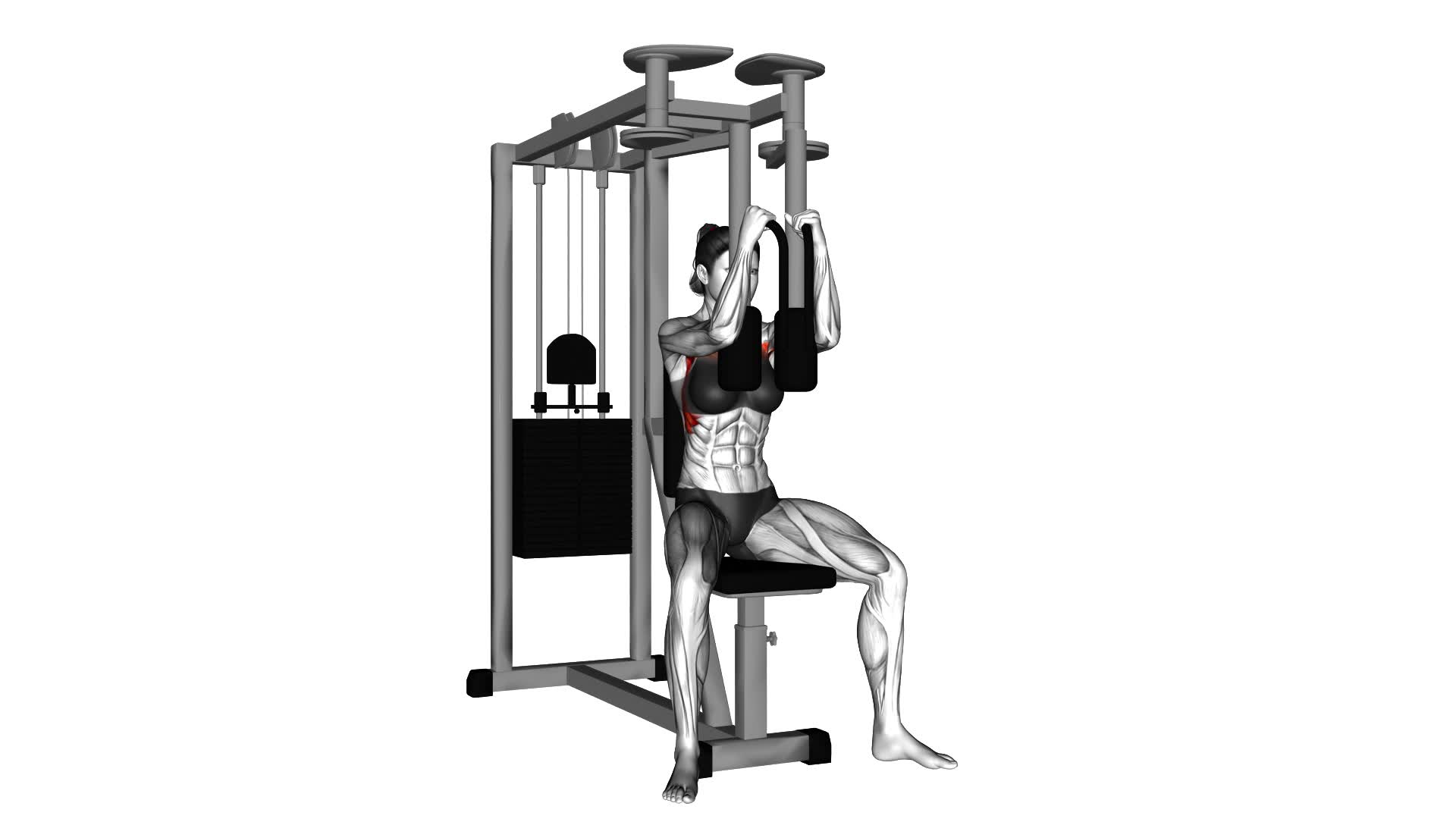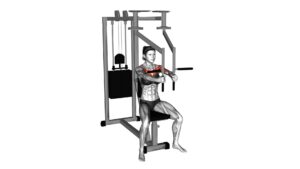Lever Pec Deck Fly (female) – Video Exercise Guide & Tips

Looking to tone and strengthen your chest muscles? Look no further than the lever pec deck fly!
Watch This Exercise Video
This exercise targets your pectoral muscles, giving you a sculpted and defined chest.
In this video exercise guide, we'll show you the proper form and technique to maximize your results.
We'll also share variations to increase the intensity and common mistakes to avoid.
Get ready for a safe and effective workout that will leave you feeling strong and confident.
Let's get started!
Key Takeaways
- Lever Pec Deck Fly targets pectoral muscles for a sculpted and defined chest.
- Proper form and technique are essential for maximizing the benefits of this exercise.
- Increasing intensity through variations and progressive overload techniques can lead to greater muscle growth.
- Paying attention to safety and maintaining control during the workout is important for preventing injuries.
Benefits of Lever Pec Deck Fly
You can experience increased strength and muscle development in your chest muscles by incorporating the lever pec deck fly into your workout routine.
The lever pec deck fly is a highly effective exercise that targets the pectoral muscles, providing you with a range of advantages and impressive results.
One of the key advantages of the lever pec deck fly is that it allows for a controlled and isolated movement. By using the machine, you can avoid the risk of injury that may occur with free weight exercises. Additionally, the lever pec deck fly provides a consistent resistance throughout the entire range of motion, ensuring that your chest muscles are fully engaged and stimulated.
Another advantage of this exercise is the ability to target the inner chest muscles. The pec deck machine allows for a wide range of motion, allowing you to fully contract the chest muscles and achieve maximum muscle activation. This can result in a more defined and sculpted appearance in your chest area.
In terms of results, incorporating the lever pec deck fly into your workout routine can lead to increased strength and muscle development in your chest. As you consistently perform this exercise, you may notice improvements in your ability to lift heavier weights and perform other chest exercises. Additionally, the lever pec deck fly can contribute to overall chest muscle growth, helping you achieve a more balanced and symmetrical physique.
Proper Form and Technique
To maintain proper form and technique during the lever pec deck fly, it's crucial to position yourself correctly on the machine. Follow these steps to ensure you're performing the exercise correctly:
- Adjust the seat: Set the seat height so that your elbows are in line with the machine's handles. This will allow for a full range of motion and proper muscle activation.
- Position your arms: Grasp the handles with a neutral grip, keeping your elbows slightly bent. This will engage your chest muscles and prevent strain on your joints.
- Engage your core: Sit with good posture, keeping your back flat against the seat and your shoulders relaxed. Engaging your core will provide stability and support throughout the exercise.
Improving muscle activation is a key goal when performing the lever pec deck fly. To achieve this, start with lighter weights and gradually increase as you become more comfortable with the movement. For beginners, it's recommended to start with weights that allow you to perform 12-15 reps with proper form.
By positioning yourself correctly and using appropriate weights, you'll maximize the effectiveness of the lever pec deck fly and prevent injury.
Now, let's explore some variations to increase the intensity of this exercise.
Variations to Increase Intensity
To increase the intensity of the lever pec deck fly, try incorporating different variations into your workout routine. Advanced modifications can help you challenge your muscles even further and stimulate greater muscle growth.
One advanced modification you can try is using heavier weights. By increasing the resistance, you're imposing a greater demand on your muscles, forcing them to work harder.
Another option is to perform the exercise with a slower tempo. Slowly lowering the weights and pausing at the bottom of the movement can increase time under tension and enhance muscle activation.
Additionally, you can incorporate progressive overload techniques such as drop sets or supersets. Drop sets involve reducing the weight after reaching muscle failure, allowing you to continue the exercise with less resistance. Supersets involve performing two exercises back-to-back without resting in between, targeting the same muscle group from different angles.
These variations can help you push past plateaus and continue making progress. By incorporating these advanced modifications and progressive overload techniques, you can take your lever pec deck fly to the next level.
Now let's discuss some common mistakes to avoid to ensure optimal results.
Common Mistakes to Avoid
To ensure optimal results, it's important to be aware of common mistakes that should be avoided when performing the lever pec deck fly exercise. By avoiding these mistakes, you can minimize the risk of injuries and maximize your results.
Here are three common mistakes to avoid:
- Using too much weight: One of the most common mistakes is using weights that are too heavy. This can lead to improper form and put excessive strain on your shoulders and chest. Start with a weight that allows you to maintain proper form throughout the exercise.
- Flaring your elbows: Another mistake to avoid is allowing your elbows to flare out to the sides during the exercise. This not only reduces the effectiveness of the exercise but also puts unnecessary stress on your shoulder joints. Keep your elbows slightly bent and close to your sides throughout the movement.
- Rushing the movement: Many people tend to rush through the pec deck fly exercise, sacrificing proper form for speed. This not only reduces the effectiveness of the exercise but also increases the risk of injury. Take your time and focus on maintaining controlled and smooth movements throughout the exercise.
Tips for a Safe and Effective Workout
Ensure a safe and effective workout by prioritizing proper form and technique. To start, warm up your body before diving into your workout routine. A warm-up helps increase blood flow, raises your body temperature, and prepares your muscles for the upcoming exercises. Begin with some light cardio, such as jogging or jumping jacks, for about 5-10 minutes. This will help prevent injuries and improve your overall performance.
Another crucial aspect of a safe and effective workout is proper breathing. Breathing correctly during exercise helps deliver oxygen to your muscles and improves your stamina. Remember to inhale deeply through your nose and exhale through your mouth. This will help you maintain control and focus during each repetition.
Additionally, pay attention to your form and technique throughout your workout. Performing exercises with proper form not only maximizes results but also minimizes the risk of injury. Take your time to learn the correct technique for each exercise and focus on maintaining it throughout your sets.
Frequently Asked Questions
How Many Calories Does the Lever Pec Deck Fly Burn?
The lever pec deck fly exercise is a great way to work your chest muscles and burn calories. When performing this exercise, you can expect to burn a significant amount of calories.
The lever pec deck fly targets your chest muscles, shoulders, and triceps, helping to strengthen and tone these areas.
To maximize calorie burn during this exercise, focus on maintaining proper form, using a challenging weight, and performing the exercise at a moderate to high intensity.
Can Men Perform the Lever Pec Deck Fly Exercise?
Yes, men can perform the lever pec deck fly exercise. It isn't limited to women.
This exercise is beneficial for both genders as it targets the chest muscles, specifically the pectoralis major and minor.
By using the lever pec deck machine, you can effectively strengthen and tone your chest.
The exercise also helps improve posture and stability in the upper body.
Incorporating the lever pec deck fly into your workout routine can lead to overall upper body strength and definition.
What Other Exercises Can Be Done to Target the Same Muscle Groups as the Lever Pec Deck Fly?
To target the same muscle groups as the lever pec deck fly, you can try the cable chest fly and push-ups.
The cable chest fly is a great exercise that mimics the movement of the pec deck fly but with cables instead of a lever machine. It helps to isolate and strengthen the chest muscles.
Push-ups are another effective exercise that engages the chest, shoulders, and triceps. They can be modified to suit different fitness levels and are a staple in any chest workout routine.
Is the Lever Pec Deck Fly Suitable for Beginners?
Yes, the lever pec deck fly is suitable for beginners.
To perform this exercise with proper form and technique, sit on the machine with your back flat against the pad and your feet firmly planted on the floor.
Hold onto the handles and squeeze your chest muscles as you bring your arms together in front of you.
Avoid common mistakes such as using too much weight or rounding your back.
How Often Should the Lever Pec Deck Fly Be Incorporated Into a Workout Routine?
To incorporate the lever pec deck fly into your workout routine, consider the benefits it offers. This exercise targets your chest muscles, helping to strengthen and tone them. It can also improve your posture and enhance upper body stability.
To maximize the benefits, aim to do the lever pec deck fly 2-3 times a week. Start with a weight that challenges you, but allows you to maintain proper form. Gradually increase the weight as you get stronger.
Conclusion
In conclusion, the lever pec deck fly exercise is a great way for women to target their chest muscles and improve upper body strength. By following proper form and technique, using variations to increase intensity, and avoiding common mistakes, women can have a safe and effective workout.
Remember to always listen to your body, start with lighter weights, and gradually increase the resistance to avoid injury.
Keep up with this exercise and enjoy the benefits it brings to your overall fitness.

Author
Years ago, the spark of my life’s passion ignited in my mind the moment I stepped into the local gym for the first time. The inaugural bead of perspiration, the initial endeavor, the very first surge of endorphins, and a sense of pride that washed over me post-workout marked the beginning of my deep-seated interest in strength sports, fitness, and sports nutrition. This very curiosity blossomed rapidly into a profound fascination, propelling me to earn a Master’s degree in Physical Education from the Academy of Physical Education in Krakow, followed by a Sports Manager diploma from the Jagiellonian University. My journey of growth led me to gain more specialized qualifications, such as being a certified personal trainer with a focus on sports dietetics, a lifeguard, and an instructor for wellness and corrective gymnastics. Theoretical knowledge paired seamlessly with practical experience, reinforcing my belief that the transformation of individuals under my guidance was also a reflection of my personal growth. This belief holds true even today. Each day, I strive to push the boundaries and explore new realms. These realms gently elevate me to greater heights. The unique combination of passion for my field and the continuous quest for growth fuels my drive to break new ground.







